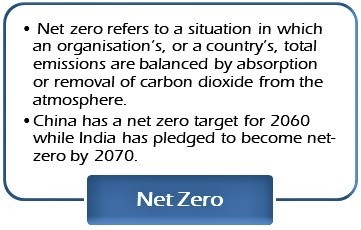7667766266
enquiry@shankarias.in
Why in news?
Prime Minister Narendra Modi’s surprise declaration of enhancements in India’s emissions reduction targets at the COP26 Climate Summit in Glasgow did not get the enthusiastic reviews the Government may have expected.
India’s INDC Targets under Paris Agreement 2015
- To reduce the emissions intensity of its GDP by 33 to 35 % by 2030 from 2005 level.
- To achieve about 40 % cumulative electric power installed capacity from non-fossil fuel based energy resources by 2030.
- To create an additional carbon sink of 2.5 to 3 billion tonnes of CO2 equivalent through additional forest and tree cover by 2030.
Global Methane Pledge was first announced by the US and EU to cut down methane emissions by up to 30 % from 2020 levels by the year 2030.

References